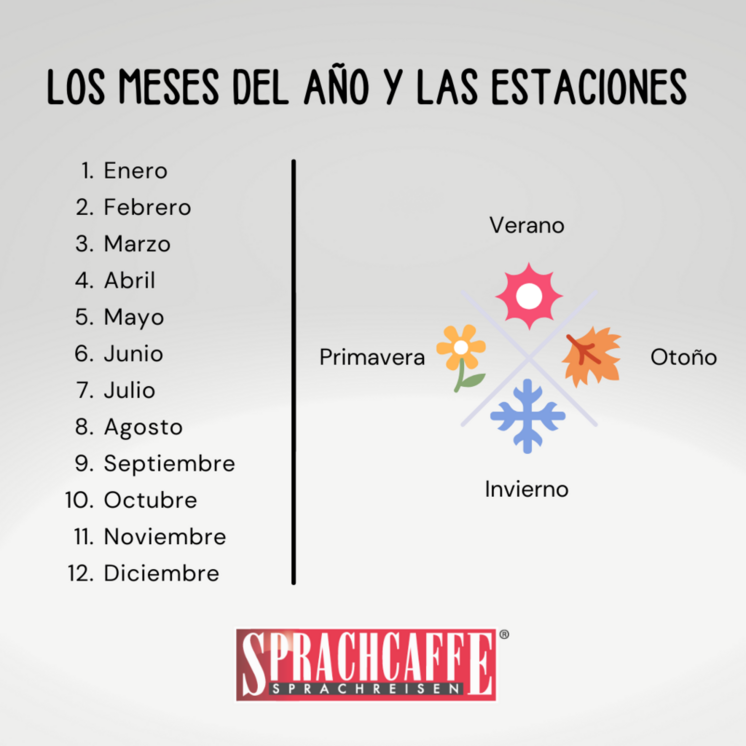Learn Spanish Months and Seasons
The 12 Months in Spanish

The twelve months of the year are always written in lowercase in Spanish and are all masculine, but they are never preceded by the definite article "el"; instead, they are introduced by the preposition "en." Here's an example: En enero nieva.
For a little variety and local knowledge, we've added the typical weather for the 12 months in Spanish for Spain and Latin America as additional information. You'll notice that most Spanish months are spelled very similarly to the English months. Only January differs more significantly in Spanish. We'll start with that month:
January:
Spanish temperatures in January typically range between 5°C and 16°C, with snowfall possible in the mountainous regions. In Latin America, temperatures are pleasant and rain is possible.
February:
It continues to rain in Spain, but temperatures gradually rise. In Latin America, it rains frequently and the weather remains warm.
Marzo | March:
Spring begins in Spain in March, with temperatures between 7°C and 15°C. In Latin America, the climate is warm, especially in tropical regions.
April:
Spring is in full swing in Spain, with pleasant temperatures between 11°C and 21°C. In Latin America, the weather remains warm, and it rains in the tropical regions.
May | May:
Temperatures in Spain in May are warm and sunny, ranging between 14°C and 25°C. In Latin America, the rainy season begins in some areas.
June:
In Spain, it's getting warmer with temperatures between 16°C and 32°C. In Latin America, it rains frequently, and winter begins in the Southern Cone.
July | July:
The heat in Spain increases in July, especially in the interior and the south. In Latin America, the rainy season continues and temperatures drop.
August:
Spain is suffering from extreme heat in many areas. In Latin America, temperatures continue to drop; it is winter in the Southern Cone.
September:
In Spain, the climate remains warm, but temperatures gradually drop to between 19°C and 30°C. In Latin America, rainfall begins to decrease and temperatures rise.
October:
In Spain, autumn begins with temperatures between 14°C and 24°C. Latin America has a hot climate.
November:
The climate in Spain is temperate, with temperatures between 9°C and 18°C and some rainfall. In Latin America, the climate remains warm, with rain in some specific regions.
December:
Winter in Spain is mild, with temperatures between 6°C and 15°C and possible snowfall in the mountainous regions. The climate remains warm in Latin America.
Origin of the Names of the 12 Months in Spanish
Have you ever wondered who named the Spanish months of the year and why January, in particular, is so different in Spanish?
During the Roman Empire, the months were named after various gods, emperors, ordinal numbers, or characteristics related to the seasons. Discover the hidden meaning behind the Spanish months of the year.
Enero :
The Spanish word "enero" comes from the Latin "Ianuarius," which refers to the Roman god Janus, who symbolizes beginning and end. Over time, the pronunciation and spelling evolved to "enero."
Febrero :
The Spanish month "Febrero" is derived from the Latin "februarius", which is related to the purification festivals celebrated in this month.
Marzo :
The month "Marzo" comes from the word "martius", in honor of the god Mars, the Roman god of war and spring.
Abril :
The exact meaning of the month is unclear, but it is thought to be related to the word "aperire", which means "to open" and refers to the opening of flowers and the arrival of spring.
Mayo :
The month "Mayo" comes from the Latin word "maius", after Maia, the Roman goddess of spring and plant growth.
Junio :
The word is derived from the Latin "junius", possibly in honor of Juno, the Roman goddess of marriage and family.
Julio :
Originally called "quintilis" in Latin, as it was the fifth month in the ancient Roman calendar, it was later renamed in honor of Julius Caesar.
August :
Originally called "sextilis" in Latin, it was the sixth month in the Roman calendar. Later, it was renamed in honor of Augustus Caesar.
Septiembre :
The origin of "Septiembre" lies in the Latin word "septem", which means seven, as it was originally the seventh month in the Roman calendar.
Octubre :
The month name "Octubre" comes from the Latin "octo", which means eight and was originally the eighth month in the Roman calendar.
Noviembre :
Its origin comes from the Latin word "novem", which means nine, as it was originally the ninth month in the Roman calendar.
Diciembre :
The month "Diciembre" is derived from the Latin "decem", which means ten and originally referred to the tenth month in the Roman calendar.
The 4 Seasons in Spanish

Primavera | Spring:
Begins around March 20 or 21 in the Northern Hemisphere and September 22 or 23 in the Southern Hemisphere. Temperatures gradually rise and plants and trees bloom.
Verano | Summer:
Begins around June 21 or 22 in the Northern Hemisphere and December 21 or 22 in the Southern Hemisphere. Temperatures are high and days are longer.
Otoño | Autumn:
Begins around September 22 or 23 in the Northern Hemisphere and March 20 or 21 in the Southern Hemisphere, at the equinoxes. In autumn, temperatures drop and days gradually become shorter. Leaves fall from the trees or change color.
Invierno | Winter:
Winter begins around December 21 or 22 in the Northern Hemisphere and June 21 or 22 in the Southern Hemisphere, at the solstices. In winter, temperatures drop and the nights become longer. Some animals, such as bears, hibernate.
Spanish Months and Seasons: Essential Vocabulary for Beginners

Using the months in Spanish will help you communicate more effectively. You'll need this vocabulary relatively early on, for example, to say what month you were born in or to give more precise time information.
The seasons in Spanish are also definitely part of the basic vocabulary and should definitely be learned early on.
It's best to travel to Spain or Latin America and put your new Spanish skills into practice early on. You'll be amazed at how quickly you can improve your Spanish with native speakers.





